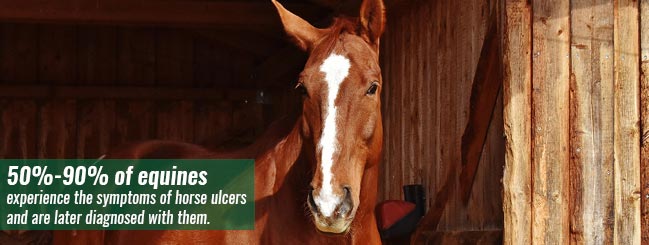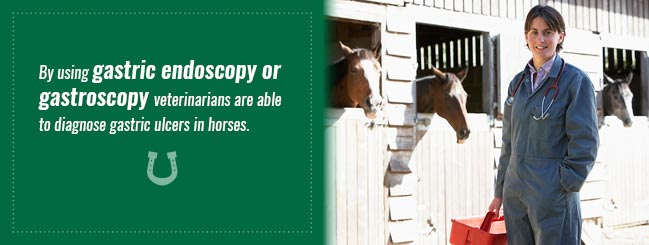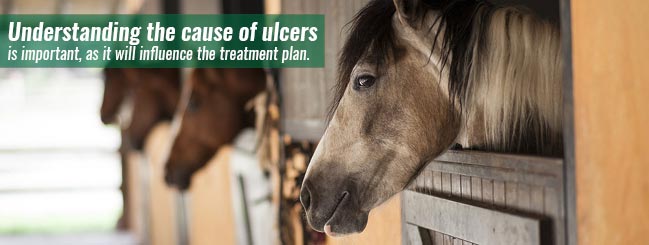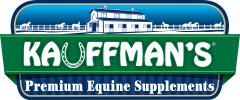Symptoms of Horse Ulcers

Ulcers are, unfortunately, a common part of horse ownership. In fact, 50 to 90 percent of equines experience the symptoms of horse ulcers and later receive a positive diagnosis for them. Performance horses are often at higher risk, with 70 percent of endurance horses and more than 90 percent of thoroughbred racehorses developing ulcers.
As an owner or rider, it’s crucial to know the signs of horse ulcers because they cause intense discomfort and seldom heal on their own. In fact, only four to 10 percent of equine ulcers heal without treatment.
Keep reading to learn about the symptoms of horse ulcers, as well as the types, treatments and preventative care available to maintain your horse’s health. As you expand your knowledge as an owner, trainer or barn manager, you’ll be able to provide better care and help your horses stay comfortable and healthy.
Types of Horse Ulcers
Horse ulcers often develop in the stomach, though they can also form in the colon. Ulcers in the stomach are referred to generally as Equine Gastric Ulcer Syndrome, but a veterinarian will provide a specific diagnosis after examining your horse. The two possible diagnoses refer to the region in which the stomach ulcers appear.
- Equine Glandular Gastric Ulcer Syndrome (EGGUS): The glandular is the lower part of your horse’s stomach. EGGUS is a rare form of Equine Gastric Ulcer Syndrome because the glandular lining can withstand harsh acids and is less susceptible to developing a sore or lesion. EGGUS occurs more often in racehorses than endurance horses.
- Equine Squamous Gastric Ulcer Syndrome (ESGUS): The squamous is the upper part of your horse’s stomach. It’s thought of as an extension of the esophagus lining. Research has shown that ESGUS is far more widespread than EGGUS. In fact, of the horses that show symptoms of Equine Gastric Ulcer Syndrome, 60 to 80 percent of them are diagnosed with ESGUS.

Ulcers in your horse’s stomach can also lead to the development of hindgut or colonic ulcers. More than 50 percent of performance horses, for example, have both gastric and colonic ulcers. Hindgut ulcers are harder to diagnose, which is why veterinarians may suggest a treatment for them as a precaution.
Signs of Horse Ulcers
You rely on your veterinarian to determine if your horse has a gastric or colonic ulcer, but they depend on you to recognize the signs. It’s crucial to know the symptoms of horse ulcers so that you can contact your vet and begin treatment as soon as possible.
EGGUS, ESGUS and colonic have identical symptoms, which include:
- Poor appetite
- Intermittent colic
- Change in attitude
- Decreased performance
- Weight or muscle loss
- Dull hair coat
- Cribbing or weaving
- Anemia
- Teeth grinding
- Discomfort near flanks
- Sporadic lameness in the hind end
- Reluctance to bend, extend or collect
- Increased periods of laying down
- Lack of energy or stamina
- Diarrhea
Experienced riders, owners and stable managers often recognize these signs early, especially when an attitude change or lethargy lasts several days. Some horse ulcer symptoms, however, are easier to miss or overlook.
If you suspect your horse isn’t feeling well but are unsure why, don’t hesitate to contact your veterinarian. An early diagnosis lets you start treatment sooner so that your horse can begin feeling better.
Diagnosis of Horse Ulcers

Veterinarians can provide an official diagnosis of a gastric ulcer through a gastric endoscopy or gastroscopy. In some cases, a vet may determine that an ulcer treatment plan is the best option without doing an endoscopy based on the horse’s symptoms and behavior.
Testing for ulcers, through an endo- or gastroscopy, requires a 12-hour fasting period. Horses are also unable to have water for four hours beforehand. The procedure itself takes around 10 to 20 minutes and is low-risk.
If your horse’s ulcer symptoms are severe, such as colic or teeth grinding, your veterinarian will most likely make an emergency call to provide immediate treatment until they can perform an endoscopy.
Endoscopies involve a few steps:
- A fast-acting tranquilizer is given to relax and sedate your horse.
- An endoscope is guided through your horse’s nostril and esophagus, then into their stomach.
- A light and camera show you and your veterinarian any potential ulcers and their severity.
It’s important to note that ulcers on the bottom of your horse’s stomach are harder to see during an endoscopy, which is why other methods for diagnosing gastric and colonic ulcers exist.
These testing methods include:
- Fecal blood test: These tests take 15 minutes to complete. Your veterinarian gathers fresh manure from your horse and mixes it with water. Then, they place samples into a cassette and see either a positive or negative result. Fecal blood tests cost less than endoscopies.
- Ultrasound: Veterinarians find colonic ulcers through ultrasounds. They use ultrasounds to see if the colon is swollen, though this can also be a symptom of other issues, like colitis.
- Manure pH test: A pH test can show if your horse’s stomach bacteria are active or inactive. A low pH indicates that bacteria counts are low, while a high pH shows the bacteria are active. Veterinarians use a meter to test and analyze the pH of your horse’s manure.
Talk to your vet about which test option is best for your horse. Depending on your horse’s medical history, such as a history of ulcers, your veterinarian may opt to use a less invasive test.
Causes of Horse Ulcers

Understanding what causes is important because it can influence your treatment plan and help you maintain long-term preventative care. Because the symptoms of horse ulcers aren’t exclusive to the different types of gastric or colonic ulcers, you’ll need to talk to your veterinarian to determine the ulcer’s cause.
As noted earlier, there are a few different types of horse ulcers. Each of these ulcers is caused by different issues.
- EGGUS: EGGUS is caused by the deterioration of the mucosal lining, which covers the glandular portion of your horse’s stomach. The breakdown of the protective lining isn’t permanent, and it will regrow after treatment, but these lesions form because of your horse’s stomach acid. One theory about the underlying cause is that non-steroidal anti-inflammatory drugs (NSAIDs) limit the lining’s blood supply. Bacterial infections are another possible reason. NSAIDs are thought of as the leading cause due to several studies that show a correlation between NSAIDs, like Bute or Banamine, and the development of EGGUS ulcers. In fact, one study found NSAIDs given at a 50 percent higher dosage led to an increase in ulcers. Research also suggests that long-term NSAID use is more likely to cause an EGGUS ulcer than short-term use.
- ESGUS: Your horse’s squamous stomach region also features a mucosal lining. The squamous, however, lacks the defensive mechanisms that protect the glandular against stomach acid, which makes it more susceptible to ulcers. ESGUS stems from either gastric acid, bacteria or parasites.
- Colonic Ulcer: Because colonic ulcers are prone to forming in response to gastric ulcers, especially those caused by EGGUS, they’re influenced by the same causes of EGGUS and ESGUS ulcers. NSAIDs, for example, are again linked to the formation of lesions in the colon when given at high doses for extended periods of time. Parasites and cysts are other potential causes of colonic ulcers.
Expect to discuss your horse’s treatment with NSAIDs and your parasite management plan with your veterinarian. This information can help your vet determine an effective, long-term treatment plan, such as substituting your horse’s NSAID.
Treatments for horse ulcers involve a combination of medicines for both short-term and long-term use. What your veterinarian prescribes is also influenced by whether your horse has EGGUS or ESGUS ulcers.
Treatment for Horse Ulcers
Medicine for EGGUS includes:
- Omeprazole: This medication is the only treatment approved by the Food and Drug Administration (FDA) for horse ulcer symptoms. The paste has an efficacy rate of almost 80 percent and works by suppressing stomach acid production. Your vet may prescribe Omeprazole in a higher dosage because it lowers gastric acid in the squamous area more than the glandular.
- Mucosal protectants: Pectin-lecithin and sucralfate are two mucosal protectants that veterinarians prescribe to treat horse ulcers. These medicines increase mucus concentration. They also provide the mucosal lining with a protective coating, which is essential because your horse’s stomach is still producing stomach acid, even with Omeprazole on board.
- Digestive supplement: Like mucosal protectants, the goal of digestive supplements is to provide your horse’s digestive system the support it needs to heal and recover. Digestive supplements help gut function and introduce beneficial bacteria back into your horse’s stomach. Kauffman’s® Equine Gold is a digestive supplement your vet may recommend.
Treating ESGUS involves similar medicines, such as Omeprazole, digestive supplements and mucosal protectants, as well as:
- H2 blockers: Cimetidine, ranitidine and famotidine are standard H2 blockers prescribed to treat horse ulcers. These blockers work by preventing histamine, a compound produced by body tissues, from stimulating your horse’s stomach and creating more gastric acid.
- Antibiotics: Veterinarians prescribe antibiotics if a bacterial infection is confirmed to have caused your horse’s ESGUS. Antibiotics are otherwise avoided because they can upset your horse’s stomach further and worsen the symptoms of their ulcers.
- Antacids: Maalox and Mylanta are two popular antacid vets recommend to support ulcer treatment. These medicines work to neutralize or decrease the pH of gastric acid in your horse’s stomach.
Colonic ulcers rely on a combination of these treatment methods, such as antibiotics and sucralfate, to ease ulcers in the colon and provide your horse relief.
Treatment courses for ulcers take around 28 days. It’s crucial to follow and complete the full treatment plan, even if your horse’s ulcer symptoms disappear. The symptoms do not resolve because the ulcer is fully healed, but because the medicine is working. Expect your veterinarian to conduct a follow-up exam, such as an endoscopy or fecal blood test, before giving you the go-ahead to end treatment.
The average cost of ulcer treatment ranges from $1,000 to more than $1,500 depending on the severity of your horse’s ulcer symptoms and condition. Generic forms of some medicines, like H2 blockers, may be substituted for a lower cost.
Because of the cost of ulcer treatments, as well as the impact of ulcers on your horse’s overall health, it’s important to take preventative steps to reduce their risk of developing them in the future.
Preventative Care for Horse Ulcers
Preventative care should become a core part of your horse’s daily life after recovering from ulcers. Many of the changes you’ll put in place relate to how and when you feed your horse. Veterinarians also recommend supportive care, such as digestive supplements, to reduce your horse’s ulcer risk factors as well.
Risk factors for ulcers include:
- Limited turnout and available pasture
- Change in diet or routine
- Frequent travel or competition schedule
- Consumption of grain-based or unprocessed grain feeds
- Rigorous exercise and training
- Diet of haylage or round bales
- Long-term use of NSAIDs
Many of these factors revolve around feeding. Horses have small stomachs, which is why they’re grazing animals. Unlike other animals that can be fed one to two times a day without issue, horses need small and frequent meals throughout the day. As grazing animals, their stomachs produce acid 24 hours a day — as much as nine gallons — and without food to neutralize that acid, their risk for ulcers increases.
You need to adapt your feeding methods to your horse’s biological digestive process. Preventative feed measures include:
- Providing daily turnout with other horses
- Offering high-quality hay or grass, like alfalfa, all day
- Feeding four or more small meals each day
- Hanging hay bags or slow feeders to encourage chewing and slower feed intake
- Mixing digestive supplements into their daily feed
Our digestive supplement provides:
- Support for the entire digestive tract
- Horse probiotics and forage products to help protect the mucosal lining
- All-natural ingredients to match your horse’s natural dietary needs
- Aid for digesting feed and enriching your horse’s diet
Browse our selection of digestive health products today, or pick up our Kauffman’s® Digestive Health to enrich your horse’s diet.
